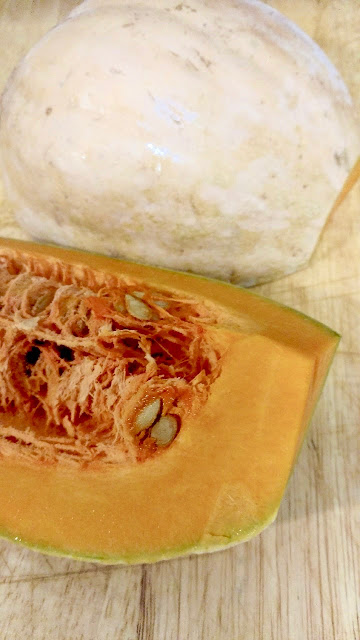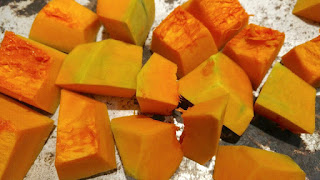
Recipe: Winter (mystery) squash looks challenging, but results are versatile and delicious

Weird on the outside, delicious on the inside:
Crazy squash. (Photos: Debbie Arrington) |
It’s time to tackle the crazy squash.
The last of the fall harvest can linger for months. (That’s why pumpkins make such great decorations.) Hard-shelled squash will keep without refrigeration for weeks. That’s why they’re nicknamed “winter squash”; you can eat them “fresh” from October through March (or longer).
But some winter squash can be a formidable challenge. First, what is it? Like all members of the squash and pumpkin family, these plants can easily cross, creating mysterious hybrids.
That’s how I ended up with a bunch of crazy squash. From the outside, they looked sort of like banana squash, but not quite as big (thankfully). Maybe they had papaya squash or more likely butternut squash in their parentage; their size and shape reminded me of a football, only rounder. (A rugby ball, perhaps?)
Their insides, once cooked, tasted like pumpkin. So that made these squash crazy versatile, too. They can go savory or sweet.
So how do you approach a football-size mystery? First, wash the skin well, scrubbing off any accumulated grime. With a long sharp knife on a firm cutting surface, cut in half, then quarters. That makes it easier to scrape out the seeds.
After seeding, peel the skin and cut the flesh into 1-inch chunks. Those chunks can be steamed; they’ll be tender in about 20 to 30 minutes. The cooked flesh can be mashed and used in any pumpkin recipe such as pumpkin bread, soup or cookies.
Those chunks also make a great side dish on their own by simply roasting. They make a tasty (and vitamin-packed) accompaniment to hearty winter meals that’s crazy good for you, too. Who knew you could enjoy “garden-fresh” fresh squash in February?
Roasted crazy squash
Serves 4 to 6

Steam the chunks and mash to use in recipes
as you would with pumpkin. Or roast them. |
Ingredients:
Comments
0 comments have been posted.Sacramento Digs Gardening to your inbox.
Sites We Like
Garden Checklist for week of April 14
It's still not warm enough to transplant tomatoes directly in the ground, but we’re getting there.
* April is the last chance to plant citrus trees such as dwarf orange, lemon and kumquat. These trees also look good in landscaping and provide fresh fruit in winter.
* Smell orange blossoms? Feed citrus trees with a low dose of balanced fertilizer (such as 10-10-10) during bloom to help set fruit. Keep an eye out for ants.
* Apply slow-release fertilizer to the lawn.
* Thoroughly clean debris from the bottom of outdoor ponds or fountains.
* Spring brings a flush of rapid growth, and that means your garden needs nutrients. Fertilize shrubs and trees with a slow-release fertilizer. Or mulch with a 1-inch layer of compost.
* Azaleas and camellias looking a little yellow? If leaves are turning yellow between the veins, give them a boost with chelated iron.
* Trim dead flowers but not leaves from spring-flowering bulbs such as daffodils and tulips. Those leaves gather energy to create next year's flowers. Also, give the bulbs a fertilizer boost after bloom.
* Pinch chrysanthemums back to 12 inches for fall flowers. Cut old stems to the ground.
* Mulch around plants to conserve moisture and control weeds.
* From seed, plant beans, beets, cantaloupes, carrots, corn, cucumbers, melons, radishes and squash.
* Plant onion sets.
* In the flower garden, plant seeds for asters, cosmos, celosia, marigolds, salvia, sunflowers and zinnias.
* Transplant petunias, zinnias, geraniums and other summer bloomers.
* Plant perennials and dahlia tubers for summer bloom.
* Mid to late April is about the last chance to plant summer bulbs, such as gladiolus and tuberous begonias.
* Transplant lettuce seedlings. Choose varieties that mature quickly such as loose leaf.